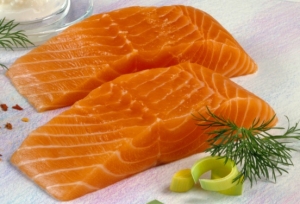Exports o f Norwegian fresh salmon fell 25 percent year-on-year in the first half of 2013, proof that the country continues to struggle getting product into China.
f Norwegian fresh salmon fell 25 percent year-on-year in the first half of 2013, proof that the country continues to struggle getting product into China.
Scotland and the Faroe Islands have both picked up market share in a Chinese fresh salmon market that grew 20 percent in the first half of this year, said Sigmund Bjorgo, director of China and Hong Kong at the Norwegian Seafood Council (NSC).
Salmon exports to China continue to hurt from difficult diplomatic relations between the two countries, tension that has its roots in the award of the Nobel Peace prize to a Chinese dissident several years ago. Bjorgo hopes that food safety authorities from the two countries will meet to iron out difficulties faced by Norwegian importers, who have seen their salmon shipments held for days at Chinese quarantine and inspection points. “Importers and distributors are finding it very difficult to get Norwegian salmon,” said Bjorgo.
Volume from Norway shrunk 60 percent in 2011 and fell again in 2012 due to new veterinary inspections which made access to the Chinese market much more difficult. Observers see the stricter inspections as retaliation by China for the award of the Nobel peace prize, though Norwegian firms like Marine Harvest continue to sell and process product in China from stocks (of cod, mackerel and other species) sourced around the world.
Much credit has gone to Norway for its marketing efforts in China: 15 years ago was the first country importing Atlantic salmon to China, and has since invested CNY 200 million (USD 33 million, EUR 25 million) growing the market through marketing at retail and restaurant level.
The U.S. and Russia account for the bulk of China’s salmon imports but this is largely frozen Pacific salmon that mainly goes to processing and re-export. Growing local consumption of Atlantic raw salmon has largely been met by supply from Norway, which due to marketing efforts has become synonymous with salmon quality in China.
Vendors at the Sanyuanli market in Beijing were this week selling “Norway salmon” at CNY 42 (USD 6.86, EUR 5.14) per 500 grams. Imported seafood is rarely identified by country of origin at the market, though labels referred specifically to the Norwegian provenance of the salmon on sale at the Sanyuanli.
NSC research has also shown 80 percent of salmon consumed in China is eaten raw while 50 percent of salmon is consumed at Japanese restaurants, largely as sashimi.
 f Norwegian fresh salmon fell 25 percent year-on-year in the first half of 2013, proof that the country continues to struggle getting product into China.
f Norwegian fresh salmon fell 25 percent year-on-year in the first half of 2013, proof that the country continues to struggle getting product into China.Scotland and the Faroe Islands have both picked up market share in a Chinese fresh salmon market that grew 20 percent in the first half of this year, said Sigmund Bjorgo, director of China and Hong Kong at the Norwegian Seafood Council (NSC).
Salmon exports to China continue to hurt from difficult diplomatic relations between the two countries, tension that has its roots in the award of the Nobel Peace prize to a Chinese dissident several years ago. Bjorgo hopes that food safety authorities from the two countries will meet to iron out difficulties faced by Norwegian importers, who have seen their salmon shipments held for days at Chinese quarantine and inspection points. “Importers and distributors are finding it very difficult to get Norwegian salmon,” said Bjorgo.
Volume from Norway shrunk 60 percent in 2011 and fell again in 2012 due to new veterinary inspections which made access to the Chinese market much more difficult. Observers see the stricter inspections as retaliation by China for the award of the Nobel peace prize, though Norwegian firms like Marine Harvest continue to sell and process product in China from stocks (of cod, mackerel and other species) sourced around the world.
Much credit has gone to Norway for its marketing efforts in China: 15 years ago was the first country importing Atlantic salmon to China, and has since invested CNY 200 million (USD 33 million, EUR 25 million) growing the market through marketing at retail and restaurant level.
The U.S. and Russia account for the bulk of China’s salmon imports but this is largely frozen Pacific salmon that mainly goes to processing and re-export. Growing local consumption of Atlantic raw salmon has largely been met by supply from Norway, which due to marketing efforts has become synonymous with salmon quality in China.
Vendors at the Sanyuanli market in Beijing were this week selling “Norway salmon” at CNY 42 (USD 6.86, EUR 5.14) per 500 grams. Imported seafood is rarely identified by country of origin at the market, though labels referred specifically to the Norwegian provenance of the salmon on sale at the Sanyuanli.
NSC research has also shown 80 percent of salmon consumed in China is eaten raw while 50 percent of salmon is consumed at Japanese restaurants, largely as sashimi.







